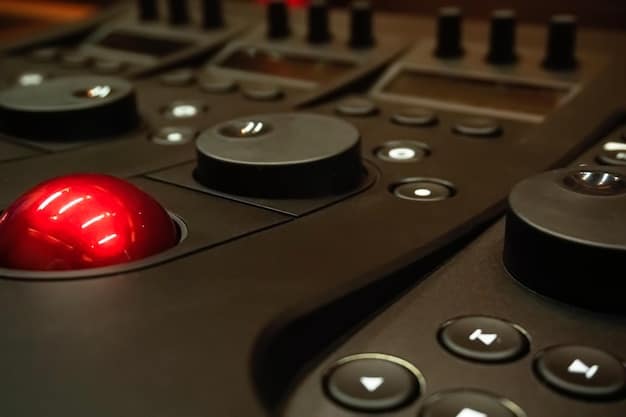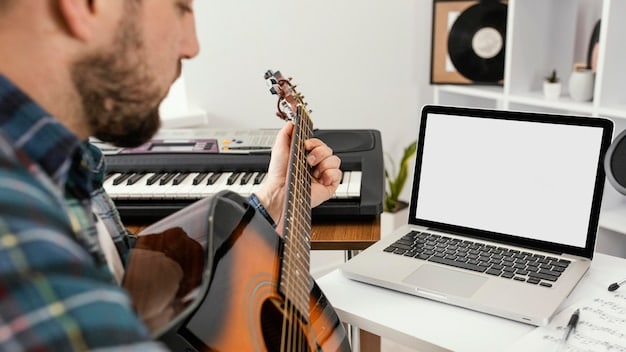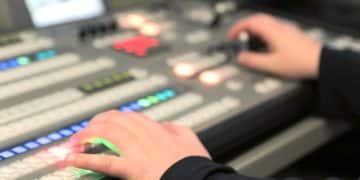Get Radio Airplay: Strategies for Emerging Independent Musicians

Getting radio airplay is crucial for emerging independent musicians aiming to broaden their audience reach and gain recognition in the competitive music industry, necessitating strategic planning and targeted promotional efforts.
For emerging artists, securing radio airplay can feel like scaling Mount Everest. You’ve poured your heart into your music; now it’s time to get it heard! This guide provides actionable strategies to help independent musicians conquer the airwaves and connect with listeners.
Understanding the Radio Landscape for Emerging Artists
Navigating the radio landscape can be daunting for emerging artists. It’s a complex ecosystem with various types of stations, formats, and listeners. Understanding this environment is the first step towards getting your music heard.
First, let’s break down the types of radio stations and their relevance to independent music.
Types of Radio Stations
Radio stations come in various forms, each with its own audience and programming style. Knowing these differences is crucial for targeting the right stations.
- Commercial Stations: These stations rely on advertising revenue and tend to play popular music. While it’s tougher to crack into these, local commercial stations can be supportive of local talent.
- Non-Commercial Stations: Often affiliated with universities or community organizations, non-commercial stations are more likely to play independent and emerging artists.
- Internet Radio Stations: Online radio stations are gaining popularity and often showcase a wide range of genres. Many internet radio stations are very open to featuring independent music.
- Satellite Radio Stations: Paid subscription services like SiriusXM can have niche channels that cater to specific genres and may feature independent artists.
Understanding the target audience of each station is equally important. Research the demographics and listen to the station to get a sense of the music they play. Matching your music to the station’s format increases your chances of getting airplay.
In summary, understanding the landscape involves knowing the different types of radio stations and what music they cater to. This initial step will make all the difference.

Crafting Radio-Friendly Music
Before even thinking about sending your music to radio stations, it needs to be radio-friendly. This doesn’t mean compromising your artistic vision, but rather understanding what resonates with radio audiences and programmers.
This involves several aspects, from song length to production quality.
Song Length and Structure
Radio stations favor songs that are concise and grab the listener’s attention quickly. Long introductions or extended instrumental sections may not work well in this format.
- Ideal Length: Aim for songs around 3 to 4 minutes in length.
- Intro: Keep the intro short and engaging, ideally under 15 seconds.
- Structure: A clear and catchy chorus is crucial. Make sure the song has a well-defined structure, like verse-chorus-verse-chorus-bridge-chorus.
Production Quality
Professional production quality is non-negotiable. Even the catchiest song will be rejected if the recording sounds amateurish.
Consider these factors when finishing the production of your song;
- Mixing: Ensure a balanced mix where all instruments and vocals are clear and distinct.
- Mastering: Mastering is essential for making your song sound polished and radio-ready, optimizing the volume and overall sound quality.
- Clarity: Good songwriting is key!
Having radio-friendly music is all about being radio-aware, so that as the artist you have a greater chance of getting your music played.
Building a Press Kit
A press kit, also known as an EPK (Electronic Press Kit), is your professional introduction to radio stations, media outlets, and industry professionals. It’s a curated package of your best work and essential information.
Your press kit is designed to intrigue and provide value to those who are going to play your music.
Essential Components of a Press Kit
A well-crafted press kit should include these essential components:
- Biography: Write a compelling bio that tells your story and highlights your achievements. Keep it concise and engaging.
- Music: Include your best tracks, professionally mixed and mastered. Make sure they are easily accessible, preferably via streaming links or downloadable files.
- Photos: High-quality photos are crucial. Include both promotional shots and live performance photos.
- Press Coverage: If you’ve received any positive reviews or media mentions, include them in your press kit.
Online Presence
Your press kit should be easily accessible online. Create a dedicated page on your website or use a platform like Sonicbids or ReverbNation.
It is important that the above components are up to date and consistent with how each piece displays who you are.
In crafting a good press kit, it’s important to be self aware of who you are as an emerging artist.

Networking and Building Relationships
Getting radio airplay often comes down to who you know. Networking and building relationships with radio programmers, DJs, and music directors can significantly increase your chances.
When wanting to get noticed, a key part is relationship building.
Attending Industry Events
Industry events, such as music conferences, showcases, and networking events, provide opportunities to meet people in the radio industry.
These kind of events, give you face to face time to build valuable connections.
- Research: Before attending, research the event and identify key people you want to meet.
- Prepare: Have your elevator pitch ready and be prepared to talk about your music.
- Follow Up: After the event, follow up with the people you met. Send a personalized email and include a link to your music.
Leveraging Social Media
Social media platforms are powerful tools for connecting with radio professionals. Engage with their content, share their posts, and build a rapport.
By being engaged and active, you create a connection that might be beneficial in the long run.
- Engage: Comment on radio professionals’ posts and share their content.
- Direct Message: Send personalized messages introducing yourself and your music. Be respectful and avoid spamming.
Having the right people recognize your music is key to climbing the musical ladder.
Targeting the Right Radio Stations
Not all radio stations are created equal for emerging artists. Targeting the right stations that align with your genre and audience is crucial for maximizing your efforts.
Knowing who to target, increases the potential for success.
Researching Radio Stations
Before reaching out to a radio station, do your homework. Understand their format, audience, and programming style. Listen to the station to get a feel for the type of music they play.
- Format: Identify stations that play your genre of music.
- Audience: Determine if the station’s audience aligns with your target demographic.
- Playlist: Listen to the station to see if they play similar artists.
Submitting Your Music
Follow the radio station’s submission guidelines. Most stations have specific procedures for submitting music, whether it’s through an online portal or via email.
Make sure to take note of their guidelines, and follow them closely.
- Guidelines: Follow the station’s submission guidelines to the letter.
- Personalize: Personalize your email or submission. Avoid generic templates.
- Follow Up: Follow up after a reasonable amount of time. Be polite and respectful.
Targeting the correct stations will increase your chances of being heard by the right personnel.
Following Up and Persistence
Getting radio airplay is rarely a one-and-done process. Following up and persistence are key to staying top-of-mind with radio programmers and music directors.
Don’t be afraid to knock on the door again and again.
Effective Follow-Up Strategies
Following up should be strategic and respectful. Avoid being overly aggressive or pushy. Be mindful of their time and workload.
- Timing: Wait a reasonable amount of time before following up, typically a week or two.
- Personalization: Personalize your follow-up email. Reference your previous communication and express your continued interest.
- Value: Offer something of value in your follow-up, such as updated press coverage or upcoming shows.
Dealing with Rejection
Rejection is a part of the process. Don’t take it personally and use it as an opportunity to improve your music and your approach.
It’s best to remember that rejection does not mean you are necessarily bad, it just means that your music might not be what they are after.
- Feedback: Ask for feedback, if possible. Constructive criticism can help you improve your music.
- Persistence: Don’t give up. Keep creating great music and keep reaching out to radio stations.
Follow up, remain consistent, and eventually you will get the “yes” you are after.
| Key Point | Brief Description |
|---|---|
| 🎵 Craft Radio-Friendly Music | Optimize song length, structure, and production quality for radio play |
| 📢 Build a Press Kit | Create a comprehensive EPK with biography, music, photos, and press coverage |
| 🤝 Network & Build Relationships | Connect with radio programmers, DJs, and industry professionals |
| 🎯 Target the Right Radio Stations | Research stations that fit your genre and audience for targeted submissions |
▼
Radio airplay significantly broadens an artist’s audience, boosts visibility, and can lead to increased streaming numbers, show bookings, and overall career advancement.
▼
A radio-friendly song typically has a concise length (3-4 minutes), a catchy chorus, a short intro, and high-quality production to capture and retain listener attention.
▼
Research stations by listening to their playlists, identifying their format and target audience, and checking for similar artists they play to ensure it aligns with your music.
▼
Include a compelling bio, professionally mixed and mastered tracks, high-quality photos, and any press coverage you’ve received to give radio stations a comprehensive view of your artistry.
▼
Networking is extremely important, as personal connections can significantly increase your chances of getting your music heard. Attend industry events and engage on social media to build relationships.
Conclusion
Getting your music on the radio as an emerging artist requires a blend of strategy, persistence, and genuine connection. By crafting radio-friendly tunes, building a strong press kit, networking effectively, and targeting the right stations, you can boost your chances of airplay and achieve your musical dreams on the airwaves.





